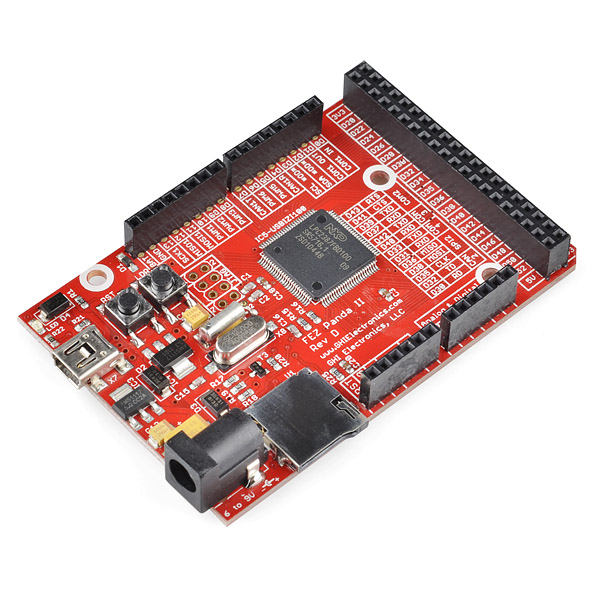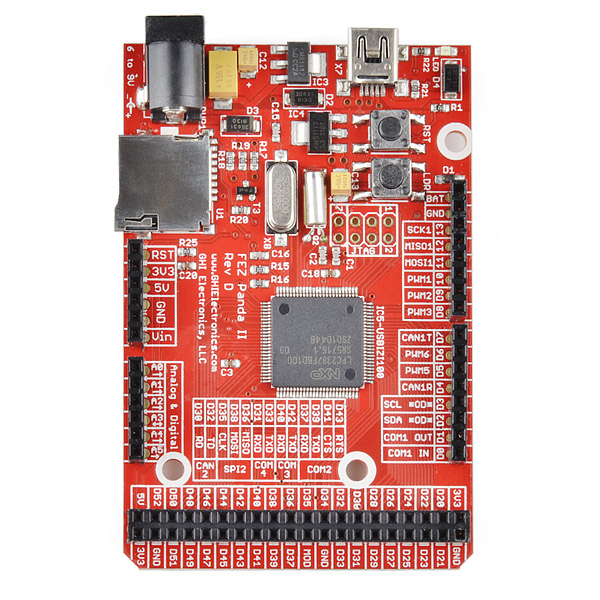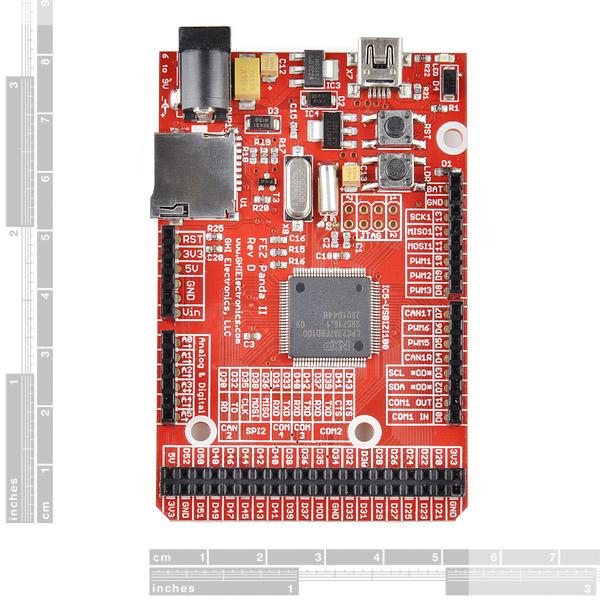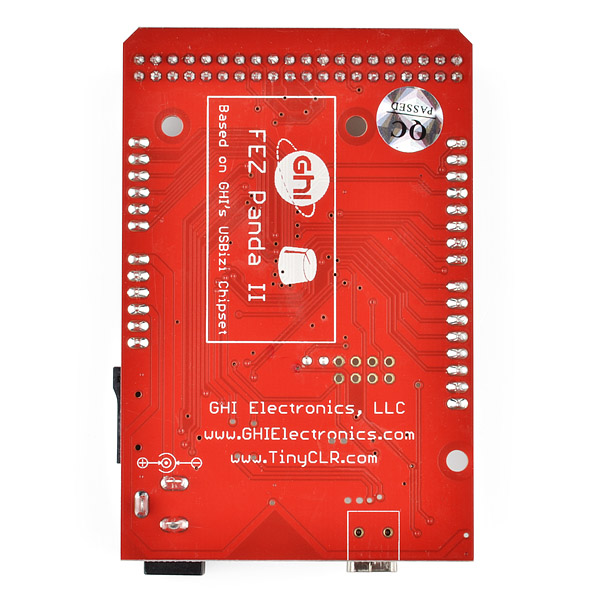FEZ Panda II
Replacement: None. We are no longer carrying the FEZ Panda II in our catalog. This page is for reference only.
The 72Mhz FEZ Panda II runs .NET Micro Framework, allowing users to program and debug FEZ Panda using Microsoft's free Visual C# Express. Applications are loaded over USB cable (or serial) with full featured debugging capabilities, such as stepping in code or inspecting variables.
FEZ Panda II is an enhanced version of FEZ Panda with On-board microSD socket, Real Time Clock, and an easily accessible 40-pin female header that exposes the extra IOs.
FEZ Panda II also includes JTAG access for those who wish to use their own firmware instead of NETMF. Using an Arduino-form-factor, you can use just about any Arduino shield. In addition, many libraries are already included like FAT file system, networking, threading, USB Client, UART, SPI, I2C, GPIO, PWM, ADC, DAC and many more.
The FEZ Panda II includes a USB cable.
- [Design Files](http://cdn.sparkfun.com/datasheets/Dev/dotNET/FEZ Panda II RevD.zip)
- Schematic
- User Manual
FEZ Panda II Product Help and Resources
Core Skill: Programming
If a board needs code or communicates somehow, you're going to need to know how to program or interface with it. The programming skill is all about communication and code.
Skill Level: Competent - The toolchain for programming is a bit more complex and will examples may not be explicitly provided for you. You will be required to have a fundamental knowledge of programming and be required to provide your own code. You may need to modify existing libraries or code to work with your specific hardware. Sensor and hardware interfaces will be SPI or I2C.
See all skill levels
Core Skill: Electrical Prototyping
If it requires power, you need to know how much, what all the pins do, and how to hook it up. You may need to reference datasheets, schematics, and know the ins and outs of electronics.
Skill Level: Noob - You don't need to reference a datasheet, but you will need to know basic power requirements.
See all skill levels
Comments
Looking for answers to technical questions?
We welcome your comments and suggestions below. However, if you are looking for solutions to technical questions please see our Technical Assistance page.
Customer Reviews
No reviews yet.






Best bang for the buck when it comes to NETMF boards! GHI support at tinyclr.com is the best anywhere.
+1 on the support. very fast responses on the tinyclr forum.
FEZ Panda || + FEZ Touch + FEZ Connect is a must have! Love it!
there's also a 'tinkerers kit' for this component combination. It's a board with headers for all 3 components, prototype area, xbee and rs232 pinouts, and includes a decent enclosure.
One piece of FEZ Color Touch is available here .. hurry
FEZ Color Touch is available here
FEZ Touch is available at FEZ Touch Color Ebay
Now that the Fez Touch and Fez Connect have been discontinued by GHI, what are the alternatives?
2 notes for anyone wanting to use their own firmware.
I am slightly confused by the input voltage. The User Manual shows 6 - 9 volts for external power on the power jack, but 6 - 12 volts for external power on the power header. Visually, I see that these are directly connected. The schematic also refers to 12V.
As my test bed (once it is disconnected from the usb cable) has a +12v source, is this safe? I don't want to invoke shipping charges for a 9 volt regulator if I don't have to.
Edit: Did some more research, and the LM1117-5 regulator that is being used by the Panda appears to have an operational rating of 15volts. So, sounds as if it should be OK. If anyone thinks otherwise, please feel free to comment before mine burns up!
Is this board capable of using the SPOT.Presentation stuff in NETMF? (with the optional FEZ Touch)
Sparkfun should carry the new Gadgeteer based Hydra kit with some of the basic addon modules!
..
To preface, I come from a .net software dev background. I used to spend a lot of time at home just trying to figure out how to deal with the microchip 18f's and building boards to utilize them. Then, I got an arduino. It was fun because it was a ready to use base. But, it uses it's own library so this knowledge doesn't readily transfer over to a commercial skill for your usual programmer job. This is fine but, I wanted something that I could play with that would also expand my usefulness at work. In my opinion this is the easiest piece of hardware to get running and configure out of all of them. It took me a half of a day to start talking i2c to the touch shield and start building reusable classes. With the class, it now takes me about 5 lines of code to add a new i2C device and talk with it. Totally, awesome! If you have experience with any .net language, this is definitely the way to go. It utilizes your existing experience and draws on a HUGE knowledge base (MSDN).
Is anyone aware of any prototyping shields specifically for the Fez Panda II that use the 40-pin expansion IO? Something along the lines of how the Arduino Mega has http://www.sparkfun.com/products/9346.
For those who dislike/hate .NETMF, check this following link to turn your FEZ Panda (I or II) into a ARM Developer Board. It really works and its great, I'm loving my FEZ Panda thanks to this.
http://www.tinyclr.com/forum/1/4219/
This free ebook is worth mentioning http://www.ghielectronics.com/downloads/FEZ/FEZ_Internet_of_Things_Book.pdf
im curious could u put the arduino firmware so u dont have to learn to types of code for a project that involes a arduino and this thing
There is a little learning moving from arduino to .NET C# but then you get a lot more.
Microsoft libs: http://msdn.microsoft.com/en-us/library/ee435793.aspx
GHI libs: http://www.ghielectronics.com/downloads/NETMF/Library%20Documentation/Index.html
and there is a free ebooks that covers it all: http://www.ghielectronics.com/downloads/FEZ/FEZ_Internet_of_Things_Book.pdf
This is more than capable of communicating with an Arduino out-of-the-box over SPI/I2C or straight-up asynchronous serial. And I think most people would agree that .NET is even more comfortable to work in than the C-based toolkit that Arduino exposes.
Obviously you wouldn't be able to put the Arduino serial bootloader on this thing without a substantial port; and even then, setting up the Arduino IDE with an ARM toolchain would be a huge pain in the butt -- the real question: why would you want to?
Is there an "Ethernet built-in" version of this? Would Arduino Ethernet shield work?
Yes you can use arduino ethernet shild, even better, full professional networking drivers are provided, including TCP/UDP/HTTP. http://www.ghielectronics.com/downloads/NETMF/WIZnet%20Library%20Documentation/Index.html
Of course this is standard .NET so the web is full of examples.
GHI also offers an enhanced "ethernet shield" called FEZ Connect.
I think you should mention, that it supports USB host as well: http://blog.tkjelectronics.dk/2011/03/fez-panda-and-usb-host/.
You should see my project, as it uses the fez panda II usb host functionality: http://blog.tkjelectronics.dk/2011/08/fez-panda-ps3controller/ :)
Yes and this is GHI's original post http://ghielectronics.blogspot.com/2011/03/usb-host-support-is-added-on-fez-panda.html
FEZ Panda II is a great product; been using it for awhile. It works even better with the FEZ Touch (320x240 LCD). There is even a couple object oriented GUIs for it!